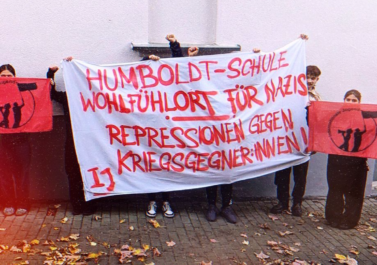
This is the fourth part of our series of translations of articles by Wildcat on the current global moment. The first part shed a critical light on the concept of ‘geopolitics’ and sketched out the current bloc formation. The second part had a closer look at the relation between China and the US within global capitalism. The third part deals with the relation between energy transition and global imperialist tension. This part analyses the current drive for militarisation and the military problems of US hegemony.
—
“Will we have war? If we prepare for war, we will have war.” (Bert Brecht)
According to Walden Bello, the very foundations of US dominance – the military, globalisation and ‘values’ – have contributed to its decline. According to Bello, the “military overstretch” began when George W. Bush started two “unwinnable wars” against Afghanistan and Iraq after 9/11. ‘Globalisation’ has made China the “locomotive of the world economy” and the “centre of global capital accumulation”. It represents 28% of global growth between 2013 and 2018, more than double the US share. And unfortunately, the waning US dominance is precisely the reason why a US war against China is looming. Bello thinks that “the Western Pacific is – much more than Ukraine – a powder keg”. [1]
There is a real risk that the US will seek military conflict with China as soon as possible, while its naval forces are still superior to China’s. The US is pouring a great deal of money into its military. Asia generates 51% of global GDP, but ‘only’ 32% of global spending on weapons. North America, with 22% of GDP, accounts for 52% of military spending, with the US alone accounting for 40% at $780 billion. China is in second place with $250 billion, while Russia is far behind with just over $60 billion. (Figures from 2022)
Deployment in the ‘Indo-Pacific’
“Great Carthage waged three wars. It was still powerful after the first, still habitable after the second. It could no longer be found after the third.” (Bert Brecht)
Since Obama’s ‘pivot to Asia’, all US presidents have intensified the confrontation with China and built up military logistics in the Pacific region. The only question dividing them is whether they should first defeat Russia in Ukraine and then turn to China, or whether they should first put an end to the war in Ukraine and then go after China with all their might. In this context, Taiwan serves as a stumbling block. It is presented as a sovereign, internationally recognised state. But the United Nations recognises the People’s Republic’s claim to all of China, including Taiwan. The 180-kilometre-wide strait between the Chinese mainland and Taiwan, on the other hand, is considered international waters by most states, while China regards it as its sovereign territory.
‘RBO‘ (Rules Based Order – see part 1 of this series) and the ‘Indo-Pacific’ emerged as public terms after the global crisis of 2008. “‘Indo-Pacific’ is a geopolitical construct: the Indian Ocean and the Asia-Pacific are understood as a contiguous… space, with India as the central counterweight to China. Today, the RBO and the Indo-Pacific are often linked and referred to together.” [2] The US has redeployed 60% of its naval forces to the Pacific and is militarily arming so-called Sentinel States along China’s Pacific border: Australia, Japan, New Zealand and South Korea. With the exception of Japan, however, the largest trading partner of these countries is not the US, but China. With the AUKUS treaty of 2021, the US, UK and Australia have massively increased military pressure on China. [3] In January 2024, Japan signed a contract to purchase 400 Tomahawk cruise missiles. At the end of July, US Secretary of Defense Austin announced in Tokyo that nuclear weapons would be explicitly included in joint war planning.
The NATO summit in July 2024 showed that the ‘North Atlantic Alliance’ is increasingly focusing on the Pacific. In the same month, a US study was published according to which a conflict between China and Taiwan could become a “case of war and alliance for NATO”. Should China attack the US bases in Hawaii and Guam, the European NATO states would have to act. From the end of June to the beginning of August, 25,000 troops from 29 countries, including the German Navy and Air Force, took part in the world’s largest naval exercise ‘Rimpac 2024’, which was led by the US. Rimpac is designed to guarantee “a free and open Indo-Pacific”.
Since 2021, the Bundeswehr has also been increasing its deployments in the region. [4] In August 2022, the air force moved one of their units there. In 2023, the army, air force and navy took part in the Talisman Sabre exercise in Australia. At the end of July 2024, the German Minister of Defense Pistorius flew to the Pacific region for a troop visit and concluded a military agreement with the Philippines. A few days earlier, the United States had granted the country military aid of 500 million Dollars – the package could grow to up to 3 billion Dollars. The West is expanding the Philippines into an aircraft carrier in the Pacific. ‘Pistorius views the Philippines as a strategic partner; in his view, a lack of values is not, in principle, a criterion for excluding German arms exports,’ commented the German weekly Die ZEIT. The son of the brutal former dictator Marcos is currently in power and the human rights situation is miserable. During his trip, Pistorius constantly invoked the “protection of the RBO”.
Because we in Europe know little about the history of the Pacific, here is a brief historical summary.
A decade after the British ‘opened’ China as a market with the ‘Opium War’, US President Fillmore did the same with Japan in 1852 with a warship. After that, the United States set up naval bases throughout the Pacific and took possession of the strategically important islands of Hawaii and the Philippines. They suppressed the guerrilla war waged by the Filipinos against the occupying forces with a ferocity that repeated itself later in Vietnam. The colonial powers fought together against the Boxer Rebellion in China. On the 14th of August 1901, 20,000 soldiers from the United States, Austria-Hungary, Great Britain, France, Germany, Italy, Japan and Russia plundered the capital Beijing and summarily executed many people. The ‘Boxer Protocol’ of the 7th of September 1901 provided for the stationing of foreign troops and ‘indemnity payments’ to the eight participating nations for 39 years – these exceeded the government’s annual tax revenue. / Fast forward / The Second World War was fought with extreme brutality in the Pacific region; a total of 1.55 million people died, including one million Japanese and 200,000 Allied soldiers. At the end of the war, the USA dropped atomic bombs on Hiroshima and Nagasaki. This was intended to stop the advance of the Soviets on the Japanese islands and was a ‘warning to Stalin’.
While the US helped Western Europe to recover with Marshall Plan funds, it tested more than 20 atomic bombs in the Pacific, the largest of which was detonated on the 1st of March 1954 in the Marshall Islands. These above-ground nuclear tests continue to wreak havoc to this day. Their consequences were a worldwide increase in cancer rates, especially in the test areas. This is why many of the indigenous peoples of this region do not see the USA as liberators at all. [5]
When the current US Chief of Staff of the US Armed Forces, Charles Brown, says that the war against China will be similar to World War II and that it can be won ‘with advanced technologies,’ he is alluding to the ‘technological superiority’ achieved by the atomic bomb at that time. And at the same time, he is talking total nonsense, because the American military is in the throes of a severe recruitment crisis. During the Second World War, 8.3 million US soldiers fought. As recently as 2003, the US invaded Iraq with more than 160,000 soldiers (including around 45,000 British). Today, no Western power has the soldiers for such military operations. Since 2014, the US Army has fallen short of its troop strength target of 494,000; due to a shortage of personnel, the Pentagon lowered the target to 470,000 in February – and currently has 445,000 active soldiers, 130,000 of them in the Pacific. (For years, the Bundeswehr has also fallen short of its target strength of 203,000 soldiers and currently has around 182,000.)
Because there are not enough soldiers, technology should fix it! But for the first time since the Sputnik shock, the West’s technological superiority in weapons is being challenged.
Hussite turning point?
“In the US Navy’s most intense naval battle since World War II” in the Red Sea, the US fired off more anti-aircraft missiles than its annual production capacity. According to Business Insider, weapons worth over a billion Dollars were already shot at the Houthis in April 2024 and yet the world’s strongest navy cannot guarantee free passage. The Houthis have attacked about 190 ships so far and hit over 50. Container shipment in the Red Sea has fallen by around 90%. [6]
The Swedish author Malcom Kyeyune sees similarities to the ‘Hussite Wars’ between 1419 and 1434. At that time, the followers of Jan Hus in Bohemia refused to elect a new monarch and insisted on their reformist interpretation of the Bible. This made them the target of five papal crusades. They were completely outnumbered, and their peasant soldiers fought against the military elite of Central Europe. But they did not lose – they were “lucky to live at a turning point in military history”. Cannons and handguns were no longer new, but the Hussites used them with new tactics. “In the relative safety of the Wagenburg, time-consuming reloading was not a major problem, and the heavy cavalry charges of the elite German knights could easily be repelled.” [7] “The German heavy cavalry was the fighter jet of 1419. Maintaining a heavily armoured knight required a lot of wealth and manpower; warhorses were specially bred and didn’t come cheap either; making high-quality weapons and armour took a lot of time and expertise, etc. The system we now call ‘feudalism’ looked the way it did not least because it was geared towards producing and maintaining these expensive full-time warriors.”
Today, Israel and the United States still have much stronger armies than their opponents. “Israel has thousands of tanks and one of the largest air forces in the world (…), the US has a dozen aircraft carriers, more than 10,000 military aircraft and a large (but shrinking) army.” But manned fighter jets are outdated – and incredibly expensive. “An F-35 stealth fighter costs about $90 million. Training a pilot can easily cost another $10 million. Annual maintenance costs another $10 million. Weapons cost extra, of course, as do the air bases or aircraft carriers needed to deploy these aircraft. An Iranian Shahed-136 suicide drone costs about $20,000.” And you don’t need expensive infrastructure and specially trained soldiers to use them. Hamas uses even cheaper drones to throw grenades at Israeli soldiers and tanks. Private consumers pay $1,000 for such an FPV drone, the military probably pays significantly less. In the war in Ukraine, FPV drones were the game changer, not the mega-expensive ‘boutique weapons’ produced in the US.
The Reaper drone was the symbol of the War on Terror and produced new dimensions in the ratio of dead civilians to dead soldiers. The fact that Julian Assange brought this to the public’s attention almost cost him his life. A Reaper drone costs 32 million Dollars. In just one month, the Houthis shot down three of them. The US aircraft carriers were the symbol of the unipolar moment: a naval power dominated the world once again. It costs $13 billion to build a modern aircraft carrier. As early as 2004, a small Swedish submarine was able to destroy what was then the newest carrier in an exercise. Other NATO exercises also repeatedly came to the same conclusion. Kyeyune sees the “emergence of a new, Hussite revolt” today. “Unfortunately for us, we are the Germans, not the Czechs.”
“Mistakes made in anger”
The main reason why the West is not winning the wars in Ukraine and Gaza is that the world’s view of the West has changed. After the massacre of the 7th of October 2024, Joe Biden said to the Netanyahu government that the US had made “mistakes out of anger” after 9/11, and that Israel would do well not to repeat them. How does that sound to Afghans? Far more than 176,000 Afghans, including around 50,000 civilians, were killed after the invasion. For Iraqis? The Iraq war, which was waged on the basis of false pretexts and in violation of international law, resulted in tens of thousands of deaths. “Mistakes”? For 20 years, the West has cynically and inhumanely pursued the War on Terror, as if it had nothing and no one – especially no international law – to fear. After Abu Ghraib, the USA had gambled away its reputation as a bringer of democracy, and the Netanyahu government has far surpassed it. This is now backfiring worldwide.
Feudalism looked the way it did because it was geared towards producing and maintaining expensive full-time warriors, writes Malcom Kyeyune. Michael Hudson sees the US in a very similar situation: “The US is extremely indebted, its real estate prices are so high and its medical care so expensive (18% of GDP) that it is not competitive. Without radical reforms, reindustrialisation is not possible.” [8] However, the digital-military-industrial complex makes a great deal of money from armament and war – and is powerful enough to block such reforms.
In view of these developments, Toni Negri revoked the “Empire” thesis in August 2022, before his death. In view of Gaza (Israel had just attacked the Gaza Strip and the West Bank again in Operation ‘Dawn’), the war in Ukraine and developments in the ‘Indo-Pacific’, he warned that “in this turbulent transitional situation at the global level, war threatens to move to the centre of globalisation processes.” War closes the space for the struggle for equality and freedom and thus destroys emancipatory movements. To fight against war, “we need to rethink imperialism”. And we need to do so by seeing “echoes and impulses” of the class struggle in the global development of capital and in the struggle for hegemony. “We have no sympathy for any government of today’s emerging powers”, only the class struggle can break the logic of “geopolitics”. [9] During the Iraq war, we had outlined in Wildcat 66 that the only remaining hegemon will be the global working class. [10] That is our compass and a research project. We’ll keep at it!
Footnotes
[1] Walden Bello: “Crisis in the West, Opportunity for the Rest?”, counterpunch 17th of July 2024
[2] See CSS ‘The Rule-Based Order…’ op. cit.
[3] AUKUS is a trilateral military alliance which was formed in mid-September 2021 between Australia, the United Kingdom and the United States. The subject of the agreement is to support Australia in particular in the development and deployment of nuclear submarines. It is now known that New Zealand has been trying to join since 2021. The only question is how to reconcile this with New Zealand’s declared nuclear-free status. See: ‘NZ started discussing AUKUS involvement in 2021’, theconversation.com, 1st of May 2024
[4] The 2020 German ‘Indo-Pacific Guidelines’ see the Indo-Pacific as “key to shaping the international order in the 21st century.”
[5] Kate Lewis Hood “US-led mega manoeuvre faces opposition’, naval exercises in Hawaii and the Pacific Islands – anti-colonial criticism. Militarisation in the mirror of more than a hundred years of exploitation”, telepolis 28th of July 2024
[6] “The US Navy has fired off nearly $1 billion in weapons fighting threats from Iran and the Houthis”, Business Insider 14th of April 2024, and Lars Lange “Sea drones in the Red Sea: Houthis challenge challenging NATO”, telepolis 19th of June 2024 and David Goeßmann, “The Houthi trap: how the USA is losing control of the Red Sea”, telepolis 24th of July 2024
[7] Malcom Kyeyune “Cheap weapons, new wars” (New Statesman, 27th of November 2023) the second part of a three-part series on ‘the end of the new American century’
[8] Michael Hudson “The US economic empire is collapsing, Europe is afraid and China is rising”, telepolis, 3rd of August 2023. It should be added that the inefficiency of the US economy also includes the excessive prices that US defence companies charge their state. This is an argument that Hudson addresses in detail elsewhere.
[9] Negri/Mezzadra “Let’s fight the war regime globally!”, uninomade, August 2022 – euronomade.info
[10] See for example Wildcat 66, July 2003: “The Second Superpower?” online at wildcat-www.de “The decline of the US’s hegemonic position […] raises questions of a dimension that no other hegemon can fill in the foreseeable future. And in this sense, the question of the global proletariat as a ‘second superpower’ is on the agenda.” But it is precisely the fact that ‘no other hegemon’ could take the place of the USA that has made the emergence of the ‘second superpower’ so much more difficult. The working class would have been able to assert itself more easily if the new hegemon China had replaced the old one. Therefore, historical parallels, such as those the article draws, should be treated with caution!



